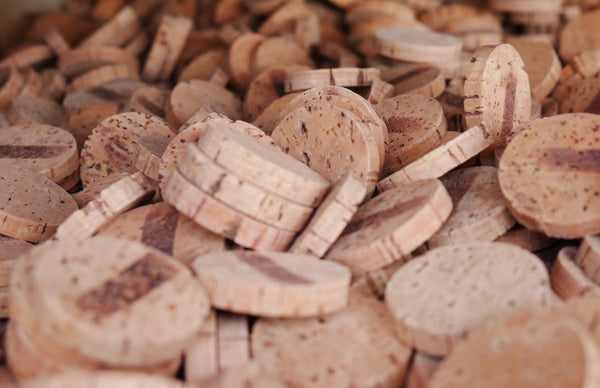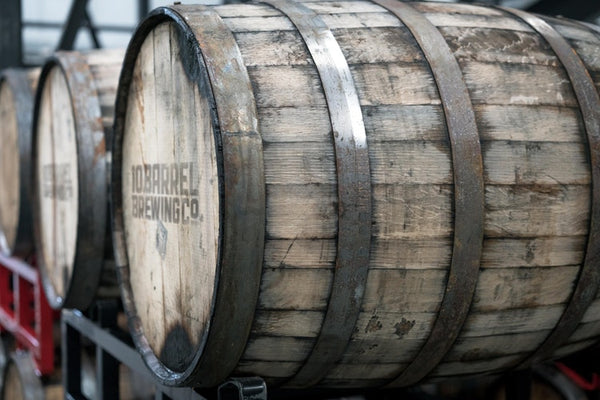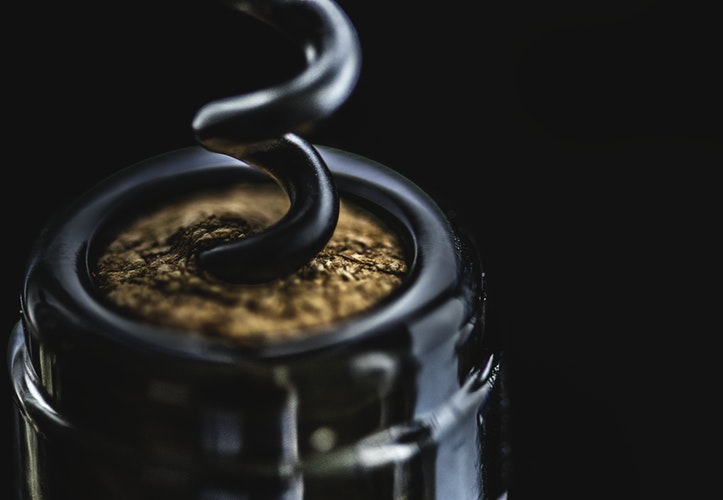
The Most Common Wine Faults and How to Detect Them
The beauty of wine is one of the reasons that so many fall under its spell; the bewitching aromas that evolve with age, the textures, the flavours, the endless complexity... yet wine is also surprisingly fragile, and it doesn't take much to knock it entirely off course. Ever noticed that your favourite wine can change quite significantly, week by week? This is mostly due to bottle variation, but if it's very different, and particularly if it's worse than before, there may also be a problem.
Wine is essentially a giant mixture of different chemicals suspended in liquid. Esthers, tannins, acids, amino acids... thousands of different, tiny molecules that contribute to the whole. Esthers give the fruity flavours we so appreciate in young wine, tannins the structure, acidity is the nervous system of a wine and so on. So what happens if this structure is compromised, in some way, or other compounds end up in the wine? This is what we know as Wine Faults. Problems. Issues. Things-that-went-wrong. It's a real pain but worst still is trying to identify exactly what happened. Most problems with wine get laid at the door of the closure, particularly if it's cork, but this is often incorrect and the real issue is never addressed. Whilst entire books have been written about the issue, we highly recommend Jamie Goode's 'Flawless' for a comprehensive view, we think there are 5 wine faults that are particularly worth knowing about: Oxidation, Cork Taint, Reduction, Brettanomyces and Volatile Acidity. It all sounds quite geeky but trust us, it's worth knowing! Let's go!

Oxidation
Oxidation is the most common fault of all, and it generally goes unnoticed. When wine is made, it's to fulfil a certain requirement of the market or it reflects the philosophy and skill of the wine-maker. Nowadays most wines are ready to drink quite early on in life and will be full of juicy fruits, fresh acidity and a supple tannic structure that means the wine doesn't have to be aged for years in order to become accessible. Oxidation is what happens when this wine is exposed to high levels of oxidation outside of the intended wine-making process, with undesirable consequences. This could either be lazy wine-making, improper storage conditions or, most likely, a poor seal (cork/screwcap).
The result is that those juicy fruits lose their edge and the wine falls flat on the palate. In very oxidised wines, there may be a noticeable 'musty' note and the colour of the wine may even change, turning a brown colour in red wines, and darkening noticeably in white wines. Due to the musty smell, this often gets blamed on cork taint, but it's an all-too common problem of its own, sadly. It's worth mentioning that certain wines are intentionally made in an oxidative manner; Sherry, Madeira and Tawny Port spring to mind!
Unfortunately for wines that are oxidised in an unintentional way, there's no solution other than to open another bottle and hope that it's fresher!

Reduction
If oxidation is a fault created by excessive exposure to oxygen, reduction is the opposite. This may sound counter-intuitive, but oxygen is an essential part of a wine-making process; it's all a question of quantity and timing. With many wines now created for accessible, easy and often short-term drinking, reduction has become more of a problem in recent years. Wine-makers, concerned that any amount of oxygen will start to degrade their product, go to extreme lengths to avoid contact with oxygen. Winery equipment is completely flushed with inert gases to displace oxygen, sulphur dioxide is used to prevent oxidation at any point during the wine-making process and the wines are often immediately bottled and sealed with a screw-cap.
So far, no problems. However, if a wine is completely deprived of oxygen, certain elements within it get upset, most notably sulphur compounds. Sulphur dioxide is a common tool in wine-making, helping to preserve freshness and to avoid oxidation. Somewhat ironically, if there is no oxygen at all, sulphur dioxide converts into hydrogen sulphide, which suppresses the fruity character of a wine and leads to unpleasant aromas of boiled cabbage at lower concentrations, and rotten eggs at very high concentrations. Other volatile compounds can be produced by reductive wine-making, producing aromas of asparagus, canned corn and sometimes a sort of rocky, mineral sensation. At low concentrations, this can actually add complexity to a wine, but it's generally undesirable if it's the dominant feature of a wine!
Fortunately, reductive wine-making can be easily countered by aerating the wine a little. You'll find that leaving your wine in a glass for even a short period of time should see most of these compounds blow off. If the wine is severely reductive, either replace it or, and trust us on this one, add a copper coin to the glass for a short period of time. Copper helps sulphur ions to precipitate out of a solution, which helps a great deal!

Cork Taint
Corks have a lot to answer for when it comes to wine faults. Many of the problems associated with oxidation are due to improperly fitted corks, many of the problems with older wines come from corks failing to maintain their structure over time, but easily the most frustrating of all is 'cork taint'. This is where a compound known as TCA forms in the cork and becomes volatile when it comes into contact with a liquid, aka wine, and ruins the profile with a pungent, musty aroma akin to wet socks and old cardboard. It also strips away the fruit from a wine so even at low concentrations, it can really change the profile of a wine!
Irritatingly, it's completely avoidable. TCA is mostly formed during the process of making cork, as a result of the cleaning process. Corks are made from the bark of the Cork Tree, which is harvested every 8-10 years or so, cleaned, processed and turned into cork. During this cleaning process, natural fungi in the bark interact with certain cleaning chemicals and create TCA, which is hard to detect until it's too late. Recently many producers have been switching to DIAM, a cork created that is treated on creation, guaranteeing that it's TCA-free. They're more expensive and don't look as beautiful as a long, natural cork but we'll take it over a ruined bottle of wine anyday!
Unfortunately, there is no solution for a corked bottle of wine other than to return it and ask for a refund/replacement. As TCA can also be present in other parts of the winery, it's also possible (although not common) for a wine under screw-cap to be afflicted by TCA!

Brettanomyces
Brettanomyces is a controversial wine fault, as it's an intrinsic element of some of the worlds most traditional wines. Brettanomyces is a naturally occurring yeast that generally appears during the fermentation process, typically towards the end as alcohol levels rise and sugar/nutrient levels are low, and is technically classified as a 'spoilage yeast'. It's attributed to poor hygiene in the winery and often as a result of not using sulphur dioxide, which inhibits its growth.
Ever smelt a wine and thought 'Wow, that's funky!'. You might be smelling 'Brett', as it's so often referred to. In small concentrations, brettanomyces can add a smoky, savoury, meaty character to a wine that's really quite endearing. However, at higher concentrations this can become dominating and the aromas become more rancid, with a blue-cheese, sweaty character appearing. In the worse case scenarios, the wine is simply pungent and undrinkable. Yet small amounts of brettanomyces are common in traditionally made Bordeaux, Chateauneuf du Pape, Rioja, Brunello di Montalcino... who's to say which level is correct? Ultimately it's a matter of personal taste but if your wine smells and tastes exclusively like a farmyard, do feel free to send it back!
Again, there is sadly no short term solution to brettanomyces and once it's in a bottle, it isn't coming out. If your wine is excessively bretty, make sure to return it.

Volatile Acidity
Last but not least, there's volatile acidity. Like brettanomyces, this courts some controversy for exactly the same reasons; at lower concentrations, its part of many a famous wine! It's, like so many faults with wine, also attributed to its relationship with oxygen. As mentioned at the beginning, there are countless chemicals and compounds suspended within wine, including various enzymes and bacteria, one of the most important being acetic bacteria. With enough exposure to oxygen, these bacteria start to convert ethanol to acetic acid, which is effectively vinegar. This acid then reacts separately with ethanol to form ethyl acetate and.... yep, we've gone too geeky, haven't we?
The net results of these reactions is a wine that has an oddly high-toned character. In small quantities, this can be quite lovely, with a lift to the wine that elevates delicate fruit and floral characters and gives the wine a bit of extra energy and verve. At higher concentration levels, the wine takes on a vinegary, sharp aroma or sometimes a chemical, nail-varnish aroma. As with brettanomyces, whether or not this constitutes a fault or not is quite a personal thing and comes down to both preference and sensitivity levels. Needless to say, your wine shouldn't be dominated by a smell of glue and/or vinegar!
Volatile acidity can sometimes feel less aggressive and prominent with some air, but like most faults, there is no way to remove it from the wine. If it's too much, make sure to have the bottle replaced!
So, you see, there are a great many things that can potentially go wrong with wine even before it makes it into your hands! Exposure to sunlight, temperatures and appropriate service are all within your control, but should you detect any of the above issues in your bottle and find it detracts from the enjoyment, don't hesitate it to the person or business who sold it to you. Good restaurants and retail outlets are both aware of the potential hazards with wine and should find a replacement bottle or offer a refund.
As always, never stop learning about the wonderful world of wine and happy drinking! May your wine be forever fault-free!
For more on our specially designed wine luggage and more detailed information on how to travel with alcohol, check out the links below:








Hinterlasse einen Kommentar
Diese Website ist durch hCaptcha geschützt und es gelten die allgemeinen Geschäftsbedingungen und Datenschutzbestimmungen von hCaptcha.